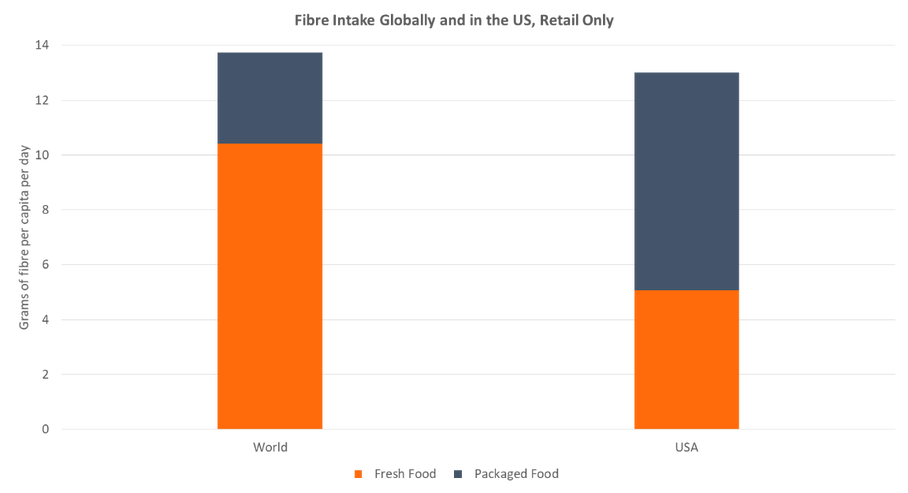Fiber is a plant component with an incredible array of health benefits and can be added to many types of food to enhance a product’s nutrition.

A treasured protector of our health, fiber is an interesting nutrient that often doesn’t receive the consumer accolades it deserves. In the world of excess and overconsumption, it seems strange that fiber is the odd one out. Commonly described as a component of a plant, which cannot be completely broken down by human digestive enzymes, fiber is associated with an array of health benefits that are underutilized by the food and drinks industries.
Recommendations and Reality
To understand the negativity around fiber, it is worth looking at official literature influencing consumers. Food and Nutrition Board (FNB) in the United States recommends 30 to 38 g of fiber daily for men and 21 to 25 g of fiber each day for women. According to Euromonitor International’s 2017 Passport Nutrition data, an estimated 19 countries consume less than 21 g/d per capita (from retail and foodservice combined). This is strikingly low, considering 43 countries overconsume calories.
The average daily energy intake in the United States (from retail alone) is 2,008 calories, whereas the average fiber intake is 13 g; approximately 60 percent of this fiber is consumed in the form of packaged food. Top-company contributors to American fiber intake are Pepsi, Kellogg and General Mills, making up 11 percent, 5 percent and 5 percent of total fiber sales from packaged food, respectively. Top-brand contributors are Doritos, Pepperidge Farms and finally Lay’s, with products mostly associated with high-calorie, -fat or -salt content. Sources of fiber in these products are as whole corn kernels in tortilla chips, whole grains in bread and crackers, and potatoes in chips.

Source: Passport Nutrition, Euromonitor International
This is different when looking at global average, incorporating developing markets, where fresh food takes up a more significant portion of the diet. Nevertheless, many developing countries underconsume calories, and show a poor representation of a healthy diet. The question is, how to overcome this imbalance of calories and fiber as a country becomes more advanced, and hence, dependent on convenience foods. How can food and beverage brands make fiber sexy?
Fiber Gives a Lot
Fiber is extremely desirable in terms of health benefits, and it comes with a list of approved health and nutrition claims. Interestingly, fiber also fits into many current trends in the food and drinks industries.
Gluten-free, still a promising category in the United States, is expected to grow by US$368 million in the 2016-2021 period (at a 7.6 percent compound annual growth rate [CAGR]), and has sparked an incredible influx of new products in the past several years. Wheat substitutes often contain a mix of unconventional grains and vegetables, which are high in fiber. For example, Really Healthy Pasta’s gluten-free Black Bean Penne contains 15 g of fiber per 100 g; in comparison, a classic durum wheat pasta only has about 2.5 g.
The case is similar with vegan, vegetarian and plant-based trends. For example, chia seeds have become a common egg-replacer in vegan products. Compared to fiberless eggs, chia seeds contain an impressive 30 percent fiber, providing one-third of the daily requirement in just a portion, similarly as in 100 g of oats. Due to their high-fiber content, they are viscous when in a moist environment, so they work in products such as cakes, yogurt or porridge pots, and dry, hot cereal mixes.
Further to this, the vegan and plant-based movements relate to an enormous area of fast-growing food and drinks categories, often much higher in fiber than animal-based products. For example, soy yogurts contain about 1 percent fiber, compared to zero in a standard dairy yogurt. A more dramatic difference can be seen in veggie or meat-vegetable burger blends, which contain up to 6 percent fiber, compared to, again, zero in an all-meat option.
Interestingly, many of the products mentioned above do not promote their high-fiber content on labels.
Fiber as an Added Ingredient
High-fiber products, such as Activia or Fiber One dessert bars, are not news, but drinks are still a fairly unexplored territory. Earlier this year, The Coca-Cola Co. released Coca-Cola Plus in Japan—with zero sugar and 5 g of dextrin (indigestible fiber) in a 470 ml serving. Coca-Cola suggested the drink suppresses fat absorption and moderates triglyceride levels in the blood after eating a balanced meal. Though an interesting idea, the drink received mixed reviews, including being compared to carbonated jelly. However, Coca-Cola was not the first to try this idea. PepsiCo released a similar drink in Japan a few years prior, but was criticized for masquerading the unhealthy aspects of the product with no substantiating evidence to show for it.
In terms of taste and texture, companies such as Taiyo or Roquette are already working on perfecting dietary fibers with SunFiber and Nutriose, respectively. Roquette is focusing on fiber that is non-viscous and neutral in taste, and can reduce the glycemic index of food (a claim approved by the European Union). On the other hand, SunFiber is designed to be easier to dissolve and therefore is perfect for use in powder and instant drinks. Though soda has proven a difficult candidate for dietary fiber, perhaps low-sugar juice drinks or 100 percent juice (which is also currently affected by sugar tax in many countries) could be it.
Fiber—a Bane or the Most Attractive Nutrient?
With tremendous versatility in form and action, and an endless list of health benefits, fiber is the next-best nutrient and ingredient. Fitting perfectly into trends, it can easily be an attractive element, and turn almost any food and drink into a “better for you” option. In fact, it could be the saving grace for some food and beverage categories, which are currently in the spotlight for high-sugar content. With a desperate need for better nutrition globally, this is the time to explore the endless possibilities of fiber in packaged food and soft drinks, for the benefit of both industry and consumers.
Sara Petersson, nutrition analyst, Euromonitor International, is responsible for producing content and improving the research behind Euromonitor International’s Passport Nutrition. Some of her roles include analysis and presentation of the Passport Nutrition data, such as per capita consumption of key nutrients globally, and their biggest contributors within packaged food, fresh food, soft drinks and alcoholic drinks. Petersson has been quoted as a nutrition authority in a number of articles and radio shows touching on subjects of global and country nutrient consumption and the possible implications on the consumer and the industry. Some examples include Reuters, The Guardian, Financial Times and the BBC World Service radio.
About the Author(s)
You May Also Like






.png?width=800&auto=webp&quality=80&disable=upscale)